Contents
Description
Sapodilla, sapotilla, Chiku, Sapotilova tree, Butter tree, Akhra, sapodilla plum, tree potato (lat.Manilkara zapóta) is a fruit tree of the Sapotov family.
Sapodilla is an evergreen, slowly growing tree with a pyramidal crown, 20-30 m tall. Leaves are elliptical glossy, 7-11 cm long and 2-4 cm wide. The flowers are small, white.
Sapodilla fruits are round or oval, 5-10 cm in diameter, with juicy yellow-brown sweet pulp and black hard seeds that can catch in the throat if not pulled out before eating the fruit. The structure of the sapodilla resembles the fruit of a persimmon. The ripe fruit is covered with a pale or rusty brown thin skin. Unripe fruits are hard and astringent in taste. The ripe fruit is soft and tastes like a pear soaked in sweet syrup.
Product geography
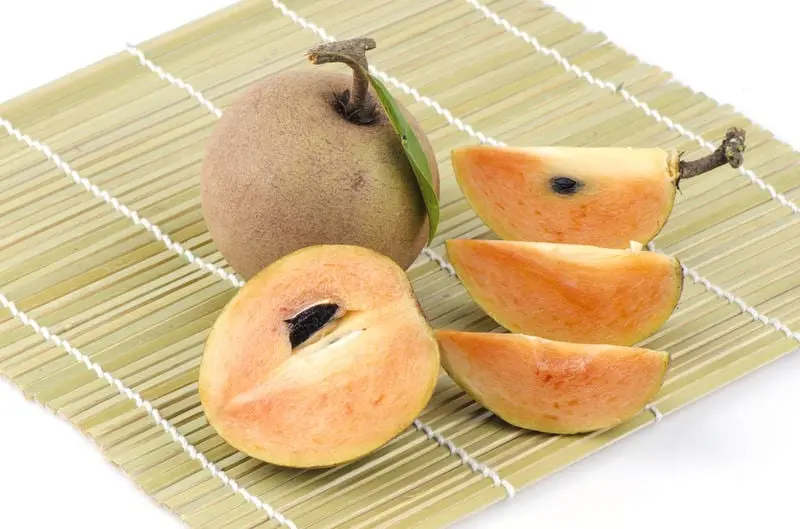
Sapodilla is native to the tropical regions of the Americas. In the countries of Asia, which are now the main exporters of fruits, the plant got into only in the 16th century. The Spanish conquistadors who were exploring the New World discovered it in Mexico, and then took the exotic tree to the Philippines during the colonization of the region.
Today sapodilla is widespread in the Asian territory. Large plantations are found in India, Thailand, Vietnam, Indonesia, Cambodia, Malaysia, Sri Lanka. These thermophilic trees continue to be grown in the tropical regions of the United States and South America.
Composition and calorie content
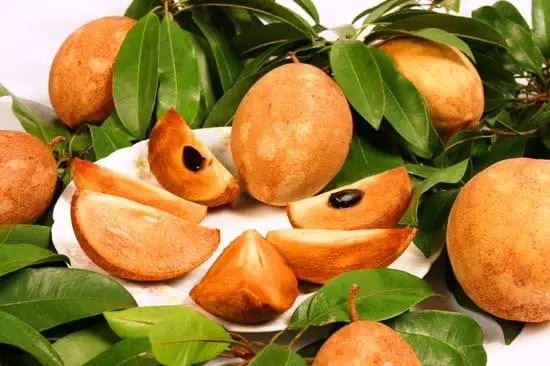
100 g of the product contains:
- Energy – 83kcal
- Carbohydrates – 19.9 g
- Proteins – 0.44 g
- Total Fat – 1.10 g
- Cholesterol – 0
- Fiber / dietary fiber – 5.3 g
- Vitamins
- Vitamin A – 60 IU
- Vitamin C – 14.7 mg
- Vitamin B 1 thiamine – 0.058 mg
- Vitamin B 2 riboflavin – 0.020 mg
- Vitamin B 3 niacin PP – 0.200 mg
- Vitamin B 5 pantothenic acid – 0.252 mg
- Vitamin B 6 pyridoxine – 0.037 mg
- Vitamin B 9 folic acid – 14 mcg
- Sodium – 12mg
- Potassium – 193mg
- Calcium – 21mg
- Stranded – 0.086mg
- Iron – 0.80mg
- Magnesium – 12mg
- Phosphorus – 12mg
- Zinc – 0.10mg
The calorie content of the fruit is 83 calories / 100 g
Taste of Sapodilla
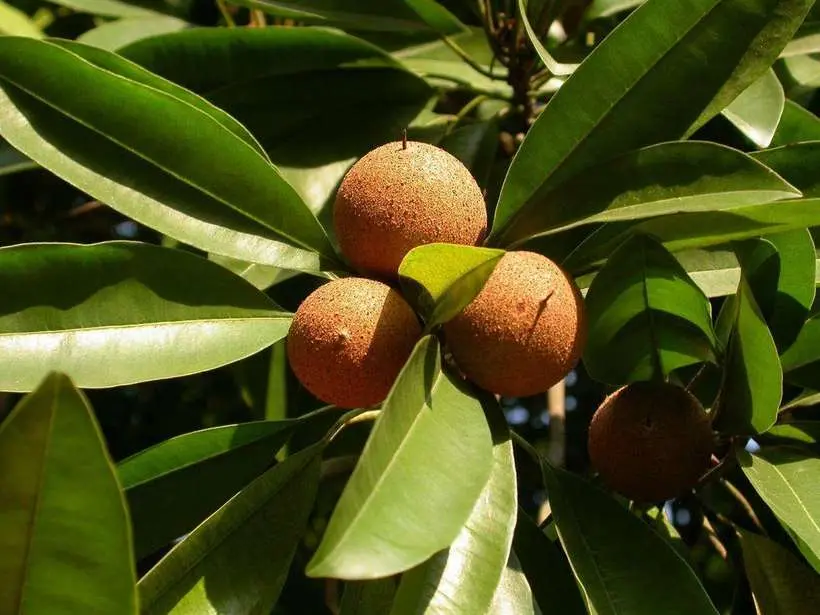
The taste of exotic sapodilla can be described in monosyllables as sweet, and in very ripe fruits – as sugary-sweet. Shades of taste, depending on the variety and personal perception, have a wide variety. The fruit can resemble a pear, persimmon, dried dates or figs, an apple soaked in syrup, caramel ice cream, boiled condensed milk, toffee, and even coffee.
The benefits of sapodilla
Sapodilla is rich in vitamins A and C, plant proteins, carbohydrates, iron, potassium and calcium. The pulp contains sucrose and fructose – a source of energy and vitality, antioxidant compounds – a tannin complex, which has anti-inflammatory, antiviral, antibacterial and antihelmintic effects. Anti-inflammatory tannins strengthen the stomach and intestines.
A decoction of the bark is used as an antipyretic and anti-dysentery agent. A decoction of the leaves is used to lower blood pressure. The liquid extract of crumpled seed is a sedative. Sapodilla is successfully used in cosmetology for regular skin care, in the fight against dermatitis, fungal infections, irritation, itching and flaking, in recovery from burns and even out complexion.
Sapodilla is added to cosmetic hair care products, especially recommended for dry and brittle hair.
Sapodilla oil has a multifaceted application: in the form of masks, in pure form and in a mixture with other oils, as a base oil with essential oils, for the preparation of massage and cosmetic mixtures, as an additive for ready-made cosmetic products: creams, masks, shampoos, balms.
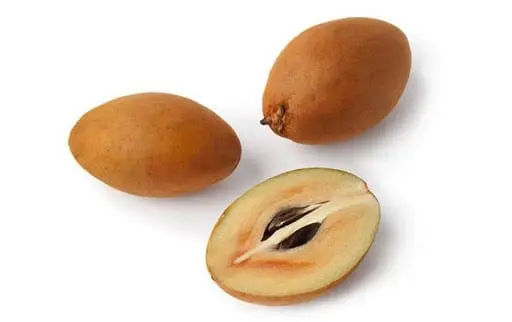
Ripe sapodilla fruits are edible fresh, they are also used to make halva, jams and marmalades, and make wine. Sapodilla is added to desserts and fruit salads, stewed with lime juice and ginger, and is used as a filling for pies.
The sapodilla milkshake is very popular in Asia.
The living tissues of the sapodilla tree contain milky sap (latex), which is 25-50% vegetable rubber, from which chewing gum is made. Sapodilla wood is used to make souvenirs.
Harm and contraindications
As with other exotic fruits, chiku should be careful when you first meet it. To begin with, you should eat no more than 2-3 fruits, then look at the reaction of the gastrointestinal tract and make sure that the fetus has not caused allergies.
The fruit has no obvious contraindications, but it should be used with caution:
- Patients with diabetes mellitus or people prone to it. Fruits contain a large amount of sugars, which can trigger an attack.
- With a tendency to obesity and during the fight against excess weight. The high calorie content and abundance of carbohydrates in lamut do not contribute to weight loss.
- Children under three years old should exclude exotic fruit from the diet to avoid allergic reactions.
How to choose Sapodilla
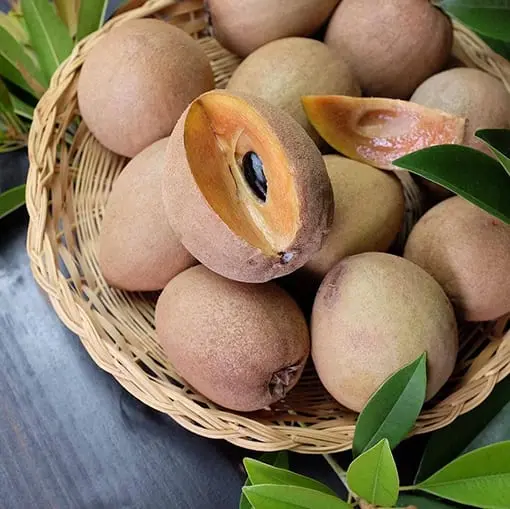
It is difficult to find chico on the shelves of European supermarkets, since the fruit is practically impossible to transport. If it is ripe from a tree, the shelf life in the refrigerator will not be more than a week, and when it is warm it will be reduced to 2-3 days. After that, the smell and taste of the fruit will greatly deteriorate, fermentation and decay processes will begin.
Unripe fruit is not recommended to eat because of the high content of tannin and latex. These substances significantly spoil the taste of sapodilla, giving it a bitterness and astringent effect, like persimmon skin. It is not always possible to ripen the fruit on its own, therefore, it is not worth hoping for a reference taste outside the zones of its growth, even if an exotic plant can be found.
When choosing fruits while traveling, special attention should be paid to their peel. It should be smooth, dense, and evenly fit the fruit. There should be no damage, cracks, or signs of rot on the skin.
To determine ripeness, squeeze the fruit between your fingers: it should wrinkle slightly. If it is too hard or very soft when pressed, the purchase should be postponed, since these signs are characteristic of immature and overripe fruits.
Application of Sapodilla

Sapodilla wood is of particular importance: it is used to extract milky latex, from which rubber and chicle are produced. The latter was used for a long time for the production of chewing gum: thanks to this substance, it acquired a viscosity.
Today, this function of the plant is dying out as growers increasingly favor synthetic bases. Rubber is used for the production of drive belts, is used instead of gutta-percha, is used in dental operations.
Milk juice is collected on special plantations only once every three years, making deep cuts in the bark. The process resembles the usual collection of birch sap. Vessels are tied to the “wounds”, where the liquid flows, which thickens almost immediately. After that, the substance is sent to molding and transported to processing plants.
Sapodilla seeds are used to make oil pomace, which is used in medicine and cosmetology. This is an excellent medicine for problem skin, its use helps fight dermatitis, eczema, inflammation and irritation. In the beauty industry, oil is used in its pure form, added to the composition of masks and creams, shampoos and balms, perfume compositions, massage products.
An affordable recipe for home cosmetology: mix sapodil and burdock oils in equal proportions, then apply for 20 minutes on the scalp and face to moisturize and nourish. To make a more nutritious mask, add yolk, heavy cream and honey to the chick butter. The mass should be spread over the face and covered with a compress on top.









